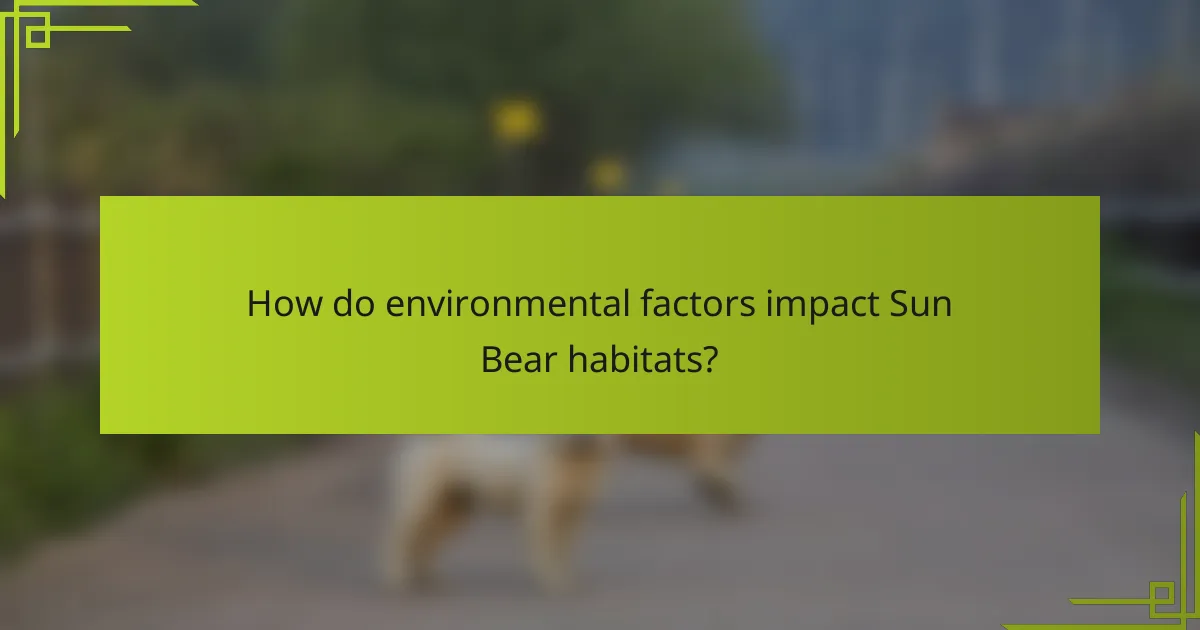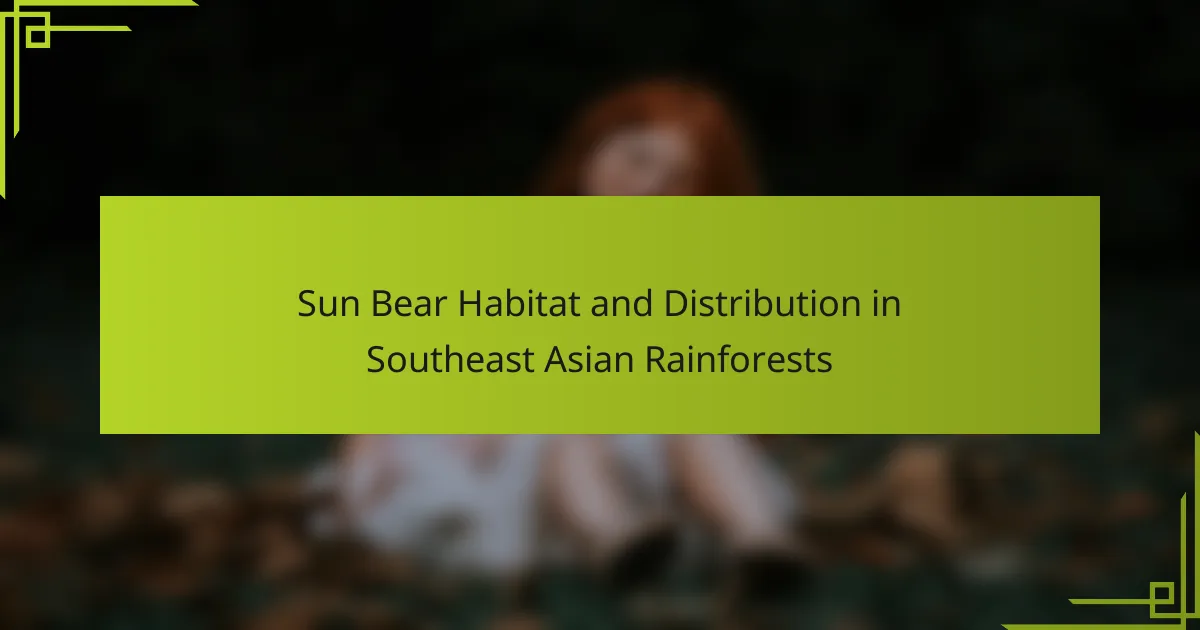The Sun Bear is the smallest bear species, found in the rainforests of Southeast Asia, including Malaysia, Indonesia, Thailand, Vietnam, and Myanmar. This species is characterized by its short coat and a distinctive yellow or white chest patch. Sun Bears play a vital role in their ecosystem as seed dispersers, contributing to plant growth and forest health. Their habitats are increasingly threatened by deforestation, climate change, and habitat fragmentation, which adversely affect their food sources and shelter. Conservation efforts are essential to protect the Sun Bear and preserve the biodiversity of Southeast Asian rainforests.

What is the Sun Bear and its significance in Southeast Asian Rainforests?
The Sun Bear is the smallest bear species, native to Southeast Asian rainforests. It has a distinctive short, sleek coat and a unique yellow or white chest patch. Sun Bears play a crucial role in their ecosystem as seed dispersers. They consume a variety of fruits, which helps in the growth of new plants. Their foraging behavior also aids in maintaining the health of the forest floor. Sun Bears are vital for biodiversity, supporting various plant and animal species. They are considered a keystone species, influencing the structure of their habitat. Conservation of Sun Bears is essential for the preservation of Southeast Asian rainforests. Their decline could lead to significant ecological imbalances in these ecosystems.
How does the Sun Bear adapt to its habitat?
The Sun Bear adapts to its habitat through several unique physical and behavioral traits. Its long, curved claws enable it to climb trees efficiently. This allows the bear to access honey and fruits high in the canopy. The Sun Bear has a short, sleek coat that helps it regulate body temperature in humid environments. Its strong sense of smell aids in locating food sources in dense forests. Additionally, Sun Bears are primarily nocturnal, reducing competition for food with other species during the day. They also have a specialized diet that includes insects and fruits, which are abundant in their rainforest habitat. These adaptations ensure their survival in Southeast Asian rainforests.
What are the physical characteristics of the Sun Bear that aid in its adaptation?
The Sun Bear has several physical characteristics that aid in its adaptation. Its short, sleek fur helps regulate body temperature in tropical climates. The bear’s long tongue, which can extend up to 10 inches, is effective for extracting honey and insects from tree bark. Sun Bears possess strong, curved claws that allow them to climb trees easily in search of food. Their small size, typically weighing between 60 to 150 pounds, enables them to navigate dense forest underbrush. The bear’s distinctive orange or yellow chest patch provides camouflage among the dappled sunlight of the rainforest. These adaptations are essential for survival in their Southeast Asian habitat.
How does the Sun Bear’s diet influence its habitat preferences?
The Sun Bear’s diet heavily influences its habitat preferences by dictating the types of environments it inhabits. Sun Bears primarily consume fruits, insects, and honey. This diet necessitates habitats rich in fruiting trees and abundant insect populations. As a result, they prefer tropical rainforests where these food sources are plentiful. The availability of tree cavities for accessing honey also shapes their habitat choice. Studies show that Sun Bears are most commonly found in areas with dense vegetation and a diverse range of flora. These habitats provide essential resources for foraging and shelter. Consequently, the Sun Bear’s dietary needs directly correlate with its preference for specific rainforest environments.
Why is the Sun Bear considered a keystone species in its ecosystem?
The Sun Bear is considered a keystone species in its ecosystem due to its role in seed dispersal and forest regeneration. By consuming fruits and other plant materials, Sun Bears help in spreading seeds across vast areas. This process promotes biodiversity and supports the growth of various plant species. Additionally, their foraging behavior creates habitats for other organisms. For example, their digging for insects aerates the soil, benefiting plant growth. Studies have shown that areas with healthy Sun Bear populations have higher tree diversity. Their presence is crucial for maintaining the ecological balance in Southeast Asian rainforests.
What role does the Sun Bear play in seed dispersal?
The Sun Bear plays a significant role in seed dispersal. As they consume fruits, they ingest seeds that pass through their digestive system. This process allows seeds to be deposited in new locations. The seeds often benefit from the nutrients in the bear’s feces. Additionally, Sun Bears can travel over large distances, spreading seeds across diverse areas. This behavior contributes to forest regeneration. Studies show that seed dispersal by Sun Bears enhances plant diversity in their habitats. Their role is crucial in maintaining healthy ecosystems in Southeast Asian rainforests.
How does the presence of Sun Bears affect biodiversity in Southeast Asian Rainforests?
Sun Bears positively impact biodiversity in Southeast Asian rainforests. They play a crucial role as seed dispersers. Their diet consists of fruits, insects, and small animals. By consuming fruits, they help in the growth of various plant species. This promotes forest regeneration and diversity. Additionally, their foraging activities create habitats for other species. Sun Bears also influence the population dynamics of insects and small mammals. Their presence supports the overall health of the ecosystem. Research indicates that areas with Sun Bears have higher plant diversity.
What are the primary habitats of the Sun Bear in Southeast Asia?
The primary habitats of the Sun Bear in Southeast Asia are tropical rainforests and lowland forests. These bears prefer dense forest cover for shelter and foraging. They are commonly found in areas with abundant fruit trees and flowering plants. Sun Bears also inhabit montane forests at higher elevations. Their habitat range extends across countries like Malaysia, Indonesia, and Thailand. Deforestation poses a significant threat to their natural habitats. Conservation efforts are crucial to protect these ecosystems.
Which types of rainforests do Sun Bears inhabit?
Sun Bears inhabit tropical rainforests. These rainforests are characterized by high humidity and dense vegetation. Sun Bears are found primarily in Southeast Asia. They prefer areas with abundant fruit trees and flowering plants. These habitats provide essential food sources. Additionally, Sun Bears are often located in lowland rainforests. They may also inhabit montane rainforests at higher elevations. The availability of trees for climbing is crucial for their survival.
How do geographical features influence Sun Bear distribution?
Geographical features significantly influence Sun Bear distribution. Sun Bears primarily inhabit tropical rainforests, which provide essential resources. Mountain ranges can limit their movement and access to food. Rivers and valleys create natural barriers that affect their range. Lowland areas, rich in fruit and insects, are preferred habitats. Altitude impacts climate, influencing vegetation types available to Sun Bears. Deforestation alters these geographical features, reducing suitable habitats. Regions with intact ecosystems support higher Sun Bear populations.

How do environmental factors impact Sun Bear habitats?
Environmental factors significantly impact Sun Bear habitats by influencing their food sources and shelter availability. Deforestation reduces the area of suitable habitats for Sun Bears. Climate change alters the rainfall patterns, affecting the growth of fruiting trees that are crucial for their diet. Additionally, habitat fragmentation isolates populations, making it difficult for Sun Bears to find mates and access resources. The degradation of forest ecosystems leads to a decline in biodiversity, which further diminishes the availability of food. Research indicates that Sun Bears rely heavily on specific tree species for nourishment and shelter, making them vulnerable to environmental changes.
What threats do Sun Bears face in their natural habitats?
Sun Bears face several threats in their natural habitats. Deforestation is a primary threat, as it reduces their living space. Habitat loss occurs due to logging and agricultural expansion. Poaching poses another significant risk, as Sun Bears are hunted for their bile and meat. Climate change affects their food sources, leading to nutritional stress. Additionally, human-wildlife conflict arises when bears raid crops, leading to retaliatory killings. These threats contribute to the declining population of Sun Bears in Southeast Asia. Conservation efforts are essential to mitigate these dangers and protect their habitats.
How does deforestation affect the Sun Bear population?
Deforestation significantly threatens the Sun Bear population. As forests are cleared, Sun Bears lose their natural habitat. This loss leads to reduced food sources, as Sun Bears primarily feed on fruits, insects, and honey found in trees. Habitat fragmentation also isolates populations, making it difficult for them to find mates. According to the IUCN Red List, Sun Bears are classified as vulnerable due to habitat loss. Increased human activity can result in direct persecution of Sun Bears. Research shows that their population has declined by over 30% in the last three decades, primarily due to deforestation and habitat degradation.
What are the effects of climate change on Sun Bear habitats?
Climate change negatively impacts Sun Bear habitats by altering their rainforest ecosystems. Increased temperatures lead to habitat loss as forests become drier and more susceptible to fires. Changes in rainfall patterns affect food availability, disrupting the bears’ foraging habits. Deforestation exacerbates these effects, reducing the area where Sun Bears can thrive. Additionally, climate change increases the frequency of extreme weather events, further threatening their habitats. Studies indicate that rising sea levels may also encroach on lowland forests, diminishing suitable living spaces for Sun Bears. Overall, these factors contribute to a decline in Sun Bear populations and their natural habitats.
How do conservation efforts aim to protect Sun Bear habitats?
Conservation efforts aim to protect Sun Bear habitats through habitat preservation and restoration initiatives. These initiatives focus on safeguarding the tropical rainforests where Sun Bears reside. Organizations work to establish protected areas to limit deforestation and habitat fragmentation. Reforestation projects are also implemented to restore degraded habitats.
Education programs raise awareness about the importance of Sun Bears and their ecosystems. Community engagement encourages local populations to participate in conservation activities. Additionally, anti-poaching measures are enforced to protect Sun Bears from illegal hunting. Research and monitoring help assess the health of Sun Bear populations and their habitats. These combined efforts aim to ensure the survival of Sun Bears in their natural environments.
What strategies are being implemented to preserve Sun Bear ecosystems?
Strategies to preserve Sun Bear ecosystems include habitat protection, anti-poaching measures, and community engagement. Habitat protection involves establishing and enforcing protected areas where Sun Bears can thrive. Anti-poaching measures include patrols and legal frameworks to deter illegal hunting. Community engagement focuses on educating local populations about the ecological importance of Sun Bears. These strategies are supported by conservation organizations and government initiatives. Research indicates that protected areas have shown a significant increase in Sun Bear populations. Collaborative efforts with local communities have also proven effective in reducing human-wildlife conflict.
How can local communities contribute to Sun Bear conservation?
Local communities can contribute to Sun Bear conservation by engaging in habitat protection and sustainable land use practices. They can participate in reforestation efforts to restore degraded habitats. Education programs can raise awareness about the importance of Sun Bears in the ecosystem. Community-led patrols can help reduce poaching and illegal logging activities. Collaborations with conservation organizations can provide resources and training. Local communities can also promote ecotourism, generating income while promoting wildlife protection. Research shows that community involvement leads to more effective conservation outcomes. For instance, the “Community-Based Conservation” model has successfully improved wildlife management in various regions.

What is the current distribution of Sun Bears in Southeast Asia?
Sun Bears are primarily distributed in the tropical forests of Southeast Asia. Their range includes countries such as Malaysia, Indonesia, Thailand, Vietnam, and Myanmar. Sun Bears inhabit lowland rainforests and montane forests. They prefer areas with abundant fruit trees and access to water sources. Population density varies across regions, with some areas experiencing habitat loss. Deforestation and human encroachment threaten their habitats. Conservation efforts are crucial for their survival in these regions.
How are Sun Bear populations monitored across different regions?
Sun Bear populations are monitored through various methods including camera traps, direct observation, and local community reports. Camera traps are strategically placed in habitats to capture images of Sun Bears and gather data on their movement patterns. Direct observation involves field researchers tracking and documenting bear sightings in their natural environments. Local communities often contribute valuable information on bear presence and behavior, enhancing monitoring efforts. Additionally, organizations collaborate with governments to conduct population surveys and assess habitat conditions. These combined approaches provide a comprehensive understanding of Sun Bear populations across different regions.
What technologies are used to track Sun Bear movements?
GPS collars are commonly used to track Sun Bear movements. These collars provide real-time location data. They enable researchers to monitor the bears’ habitat use and behaviors. Another technology used is radio telemetry. This method involves attaching radio transmitters to the bears. It allows for tracking their movements over shorter distances. Camera traps also play a role in monitoring Sun Bears. They capture images of the bears in their natural habitat. These technologies collectively enhance understanding of Sun Bear ecology.
How do population studies inform conservation strategies?
Population studies inform conservation strategies by providing critical data on species distribution and abundance. These studies help identify the current population size of sun bears in Southeast Asian rainforests. Understanding population dynamics aids in assessing the health of the species and its habitat. For instance, a study by Fredriksson et al. (2020) highlighted that population density can indicate habitat quality. Conservation strategies can be tailored based on the findings from these studies. Effective management plans often rely on population data to prioritize areas for protection. Additionally, population studies can reveal threats such as habitat loss and poaching. This information is vital for implementing targeted conservation actions.
What factors influence the distribution patterns of Sun Bears?
The distribution patterns of Sun Bears are influenced by habitat availability, food sources, and human activity. Sun Bears primarily inhabit tropical rainforests in Southeast Asia. They require dense forest cover for shelter and foraging. Availability of fruit, honey, and insects affects their presence in specific areas. Deforestation and habitat fragmentation due to agriculture reduce their range. Additionally, human encroachment impacts their movement and survival. Studies indicate that protected areas support healthier populations. Research shows that Sun Bears are more abundant in regions with minimal human disturbance.
How does habitat fragmentation affect Sun Bear distribution?
Habitat fragmentation negatively impacts Sun Bear distribution by isolating populations. This isolation limits their access to food and mates. Fragmented habitats often lead to reduced genetic diversity. Consequently, inbreeding can occur, weakening population resilience. Additionally, smaller habitat patches may not support sufficient prey. Studies show that Sun Bears require large territories for foraging. Fragmentation restricts their movement, making it difficult to find resources. As a result, the overall population may decline in fragmented landscapes.
What role do human activities play in shaping Sun Bear habitats?
Human activities significantly impact Sun Bear habitats. Deforestation for agriculture reduces their natural living space. Urban development fragments the forests, isolating populations. Illegal hunting diminishes their numbers and disrupts breeding. Pollution from nearby industries contaminates food sources. Roads and infrastructure increase human-bear conflicts. Conservation efforts are essential to mitigate these impacts. Studies show that protected areas help sustain Sun Bear populations.
What practical actions can individuals take to support Sun Bear conservation?
Individuals can support Sun Bear conservation by participating in habitat protection efforts. This includes supporting organizations that focus on preserving Southeast Asian rainforests. Donations to wildlife conservation groups can directly fund Sun Bear protection initiatives. Volunteering for local conservation projects helps raise awareness and engage communities. Educating others about the importance of Sun Bears promotes broader conservation efforts. Choosing sustainable products reduces the demand for palm oil, which threatens their habitat. Advocating for stronger wildlife protection laws encourages government action. Reporting illegal activities, such as poaching, helps protect Sun Bears in the wild. Each of these actions contributes to the overall conservation of Sun Bears and their habitats.
How can responsible tourism benefit Sun Bear habitats?
Responsible tourism can benefit Sun Bear habitats by promoting conservation efforts and generating funding for habitat protection. This type of tourism encourages visitors to engage in eco-friendly practices. It raises awareness about the importance of preserving Sun Bear habitats. Increased visitor interest can lead to financial support for local conservation projects. For example, a study by the World Wildlife Fund highlights that eco-tourism can contribute significantly to local economies. This financial inflow can help fund anti-poaching initiatives and habitat restoration efforts. Furthermore, responsible tourism can foster community involvement in conservation, ensuring that local populations prioritize protecting Sun Bears and their environments.
What lifestyle changes can help reduce threats to Sun Bears?
Reducing threats to Sun Bears requires lifestyle changes such as promoting sustainable land use and reducing deforestation. Sustainable farming practices can minimize habitat loss. Supporting eco-tourism helps protect bear habitats while providing economic benefits. Educating local communities about Sun Bear conservation fosters coexistence. Reducing illegal wildlife trade through community awareness decreases poaching risks. Advocating for wildlife protection laws strengthens legal frameworks for bear conservation. Engaging in reforestation efforts restores lost habitats. These changes collectively contribute to the preservation of Sun Bears in their natural environment.
The Sun Bear is the smallest bear species, native to Southeast Asian rainforests, and plays a crucial role as a keystone species in its ecosystem. This article explores the Sun Bear’s habitat preferences, physical adaptations, and dietary influences, emphasizing its significance in seed dispersal and biodiversity maintenance. It also addresses the threats posed by deforestation and climate change, alongside conservation efforts aimed at protecting their habitats and populations across Southeast Asia. Key strategies for community involvement and responsible tourism in supporting Sun Bear conservation are highlighted, providing a comprehensive understanding of the challenges and solutions related to this species.
